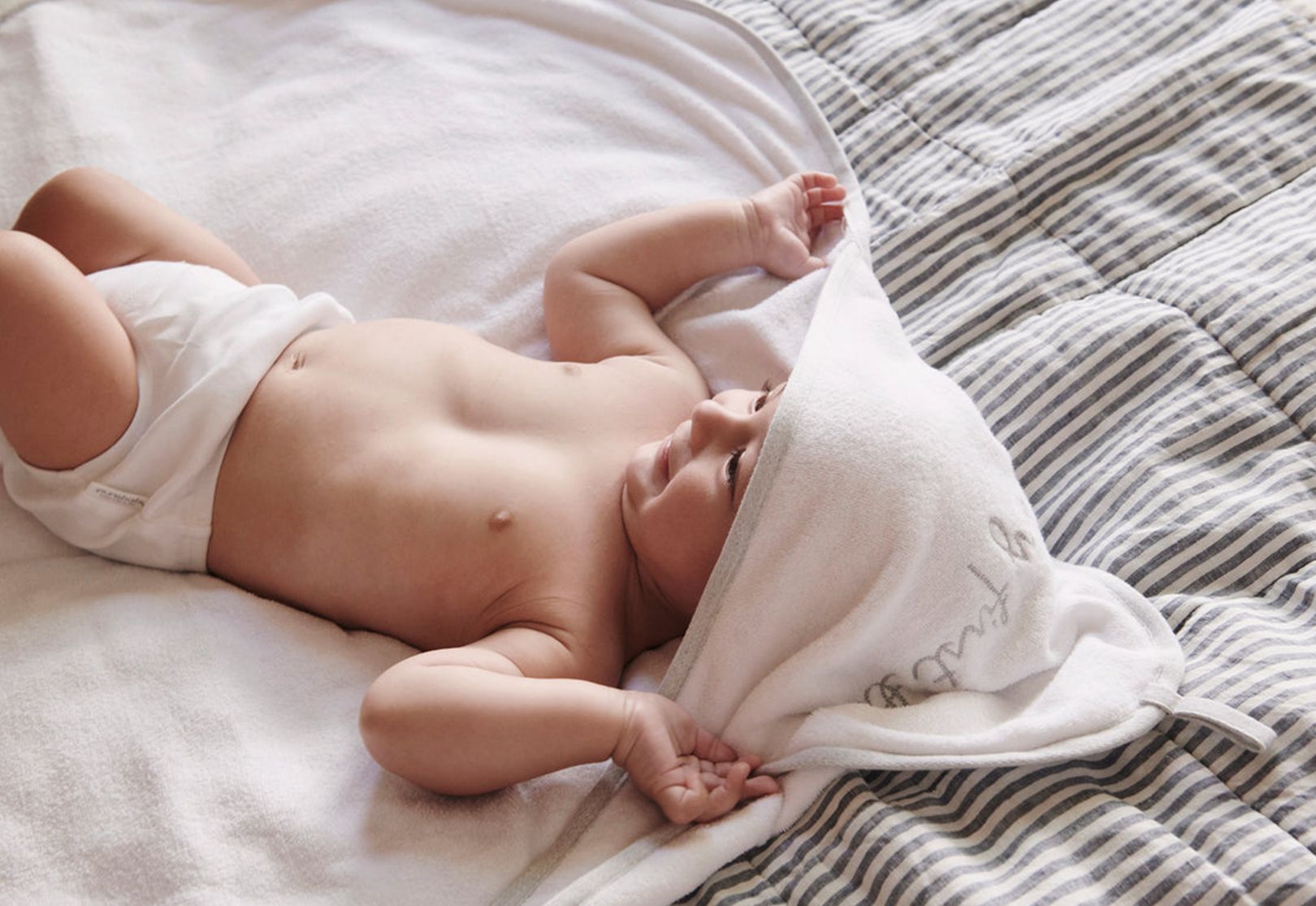
Bath Time Checklist
5 min read | 23 January 2020
15 min read | 06 September 2020
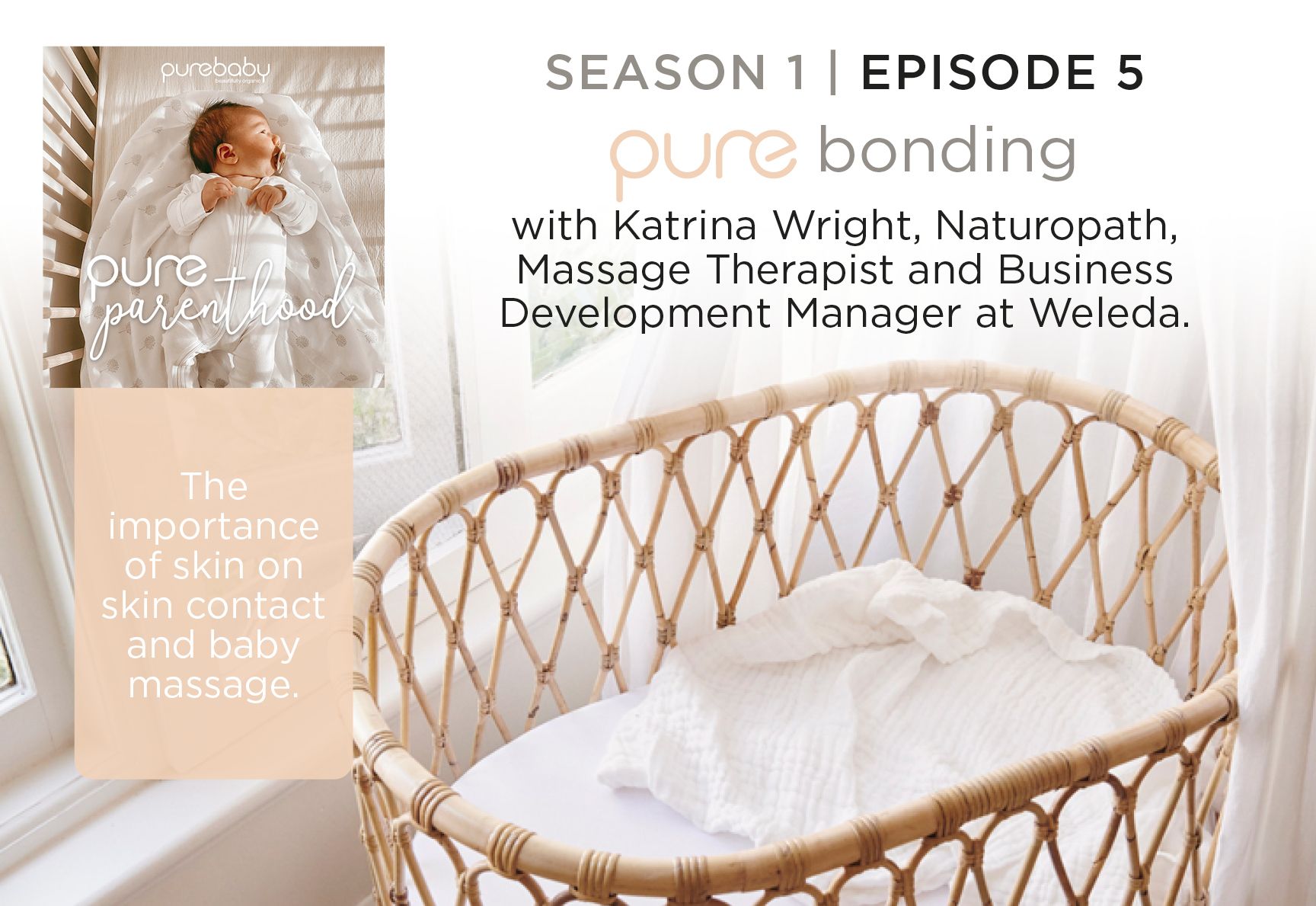
Katrina's origins dating back to 1921 to the teachings of philosopher and natural scientist, Dr. Rudolf Steiner. Katrina shares with us some baby massage techniques and the importance of skin on skin contact.
During baby massage, Katrina recommends using skincare products that are as close to nature as possible. The Weleda range is free from artificial preservatives, synthetic fragrances and silicone oils or petrochemicals. There is no animal testing or GMOs.
Baby massage is a time of pleasure and relaxation for both the parent and the baby. It can help your baby to relax and can assist in developing a unique bond between the parent and child. If you are at home with your baby, massage may also be a wonderful time for your partner or alternate caregiver to be involved with their newborn, particularly if they are not able to be home throughout the days.
Creating a calmer and more relaxed baby, which promotes a sounder and deeper sleep
Aiding the development of muscle coordination and flexibility
Healthy weight gain
Assist in the development of a strong immune system
Stimulating the digestive and circulatory system
Help to relieve digestive issues such as gas, wind and colic or constipation.
If your baby has trouble settling or sleeping, you may find that a simple massage will allow your baby to relax, which may ultimately allow baby to fall asleep faster and sleep for longer.
Take the time to focus completely on your baby and remove any distractions such as the radio or television. However, you may decide to play some relaxing music.
Ensure to remove all of your jewellery including rings, bracelets and watches, so that these do not catch on the baby’s skin.
It is important that the room is pleasantly warm and covers any parts of your baby’s body that you are not massaging to prevent the baby from getting cold. Dim lighting may also be more calming for both you and your baby.
Remember that massage is a time for relaxation so talk softly and gently to your baby. Try not to talk constantly so that your baby also enjoys peace and calm during the massage.
Before you get started, warm calendula oil or lotion in your hands by rubbing the hands together to create some friction.
Get into a comfortable position making sure your arms and shoulders are relaxed. Your hands should be flexible and in constant contact with your baby’s skin.

Start with long, gentle strokes so that your baby becomes accustomed to the movement over their skin
Try to maintain contact with your baby even when reaching for more oil. Keep one hand on the baby while you are reaching for more oil.
Use long firm strokes. Be careful not to use a very light touch so that it becomes ticklish for your baby, find just the right pressure. You will know whether your baby is enjoying the massage by simply looking at their face. Also, notice the flexion of your baby’s foot or hand as your massage over these areas.
Don't try to massage your baby just before or after a meal, or when it is nap time. Immediately after bath time may be a more suitable time as baby is already undressed and will be warm from the bath.
Massage does not necessarily mean you have to massage the entire body. You may decide to simply do a foot or tummy massage, or even just the back. Do what you feel is right for you and your baby.
Place your baby’s foot between your index and middle finger (V hold). This way you will be able to follow your baby’s flexion and extension movements while continuing the massage.
If your V hold is correct, you should be able to use both thumbs to massage the sole of your baby’s foot, the toes, the ankles and so forth. Babies love this. Both feet should always be massaged for the same time frame and you should avoid applying too much pressure to the sole of the foot.
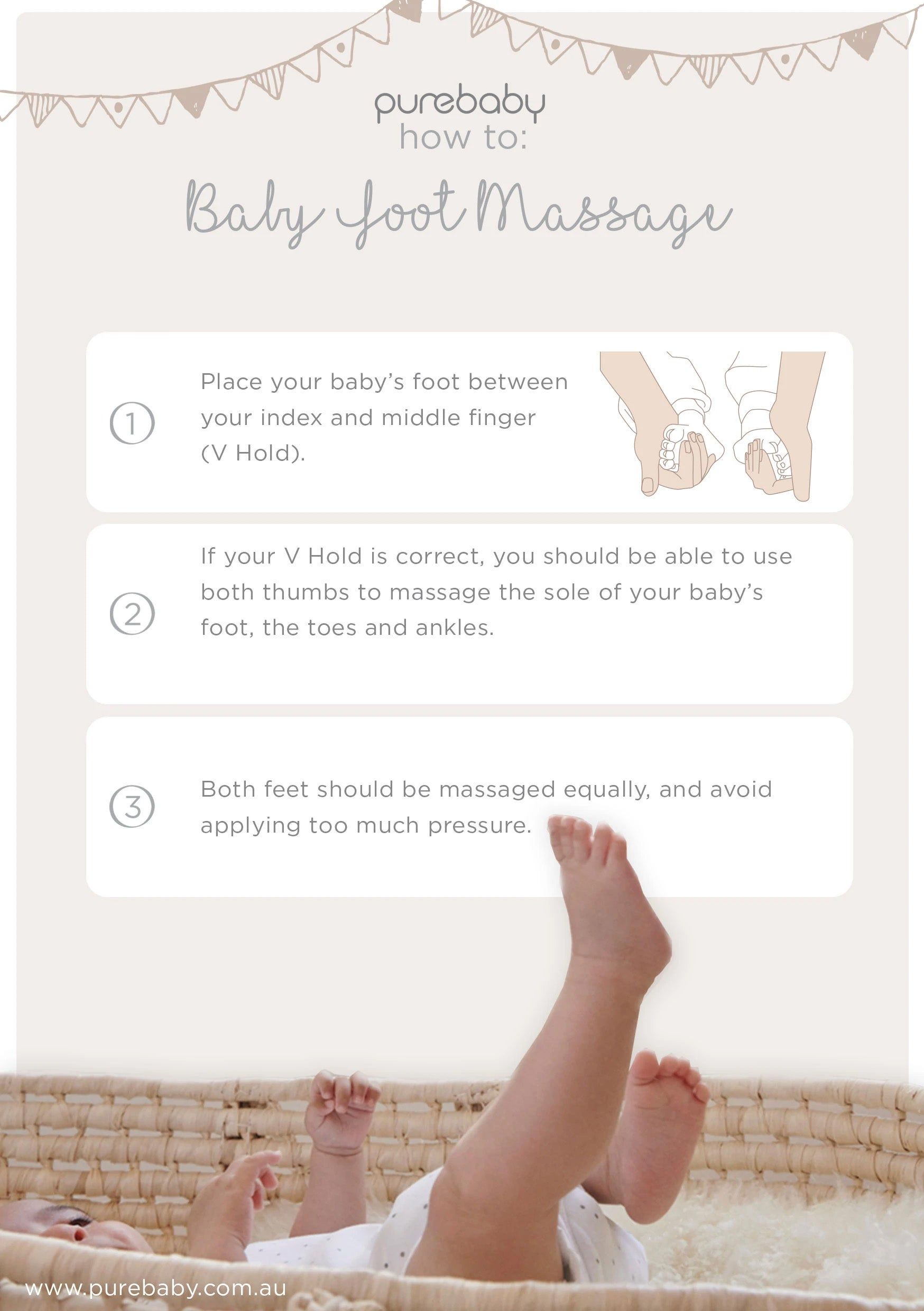
Hold your baby with their chest on yours. You may like to be slightly reclined if this is more comfortable for you and baby.
Place your right hand on your baby’s left shoulder and with a relaxed arm, slide your hand slowly towards your baby’s right buttock.
Meanwhile gently place your left hand on your baby’s right shoulder and as soon as the first hand reaches baby’s right buttock begin to gently slide your left hand down towards the left buttock.
At the same time, remove the first hand from the buttock and place it back on your baby’s left shoulder. You should get a fluid, harmonious movement using both your hands while always maintaining one hand in contact with your baby’s skin. Remember to use a firm but gentle touch so your massage is more than a caress.
Once you have finished the vertical massage technique, you may like to move onto circular movements. With one hand on your baby’s back, use the fingers to move in circles around the baby’s back and shoulders. Finish with holding the palm in the middle of the back.
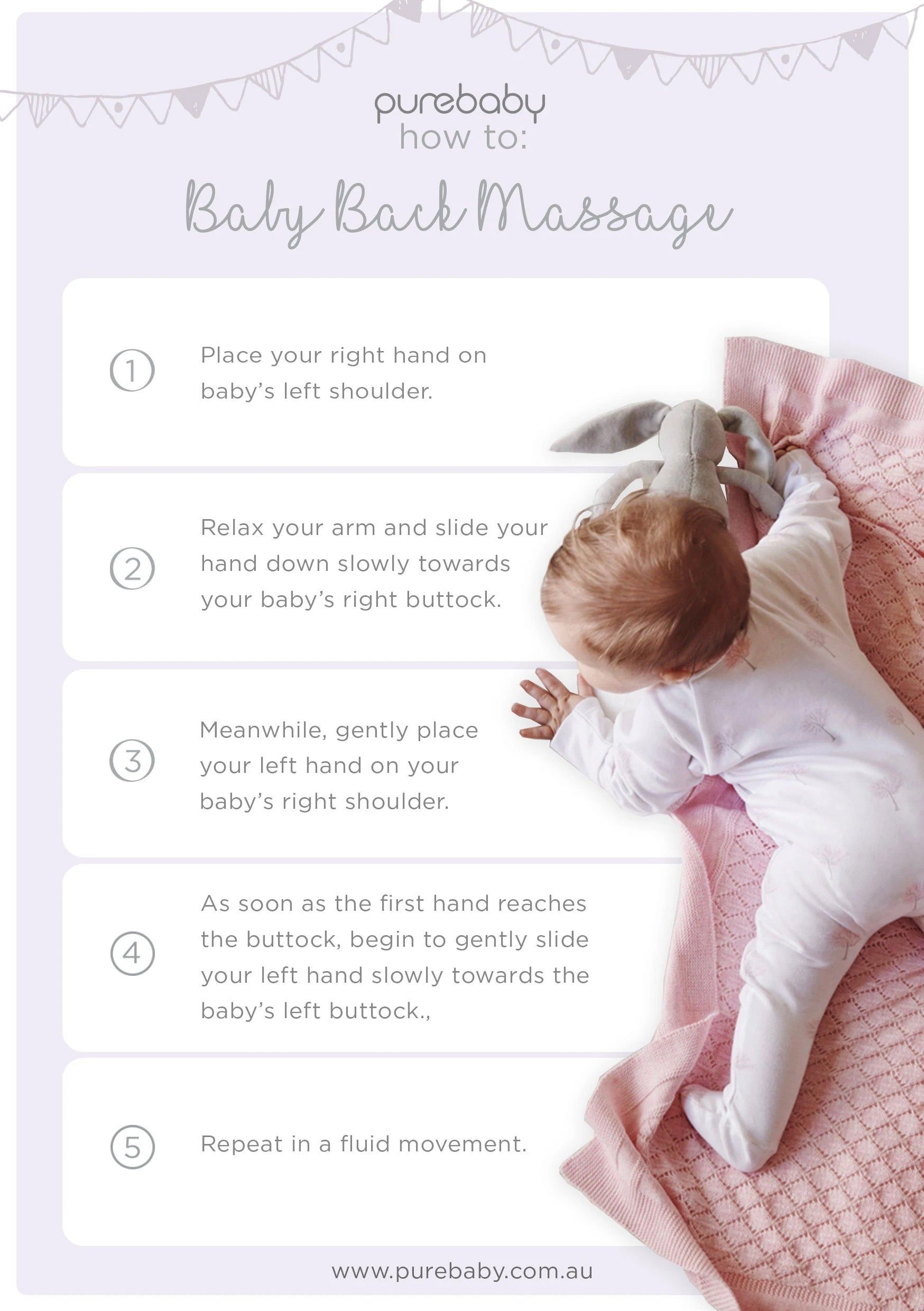
Place your baby on a warm towel on the floor. Place your forefinger and index fingers near your baby's belly button and start to move the fingers in circles in a clockwise motion. Once you have circled the belly with the fingers, you can progress to using the whole palm with a gentle, but firm touch. To finish, place your hand flat on the tummy to complete the massage with a soothing and calm touch. When massaging the tummy, always make sure you’re moving your hands in a clockwise, circular motion. This follows your baby's line of digestion.
Place your baby on their back, bring the feet together and rest them on the lower part of the stomach with the soles touching and knees pointing out towards the sides of the body. Keep the soles touching and gently rock your baby’s feet towards the nose before returning the feet to the starting position. This process can be repeated over again.
Place your baby on their back with feet flat on the floor and the knees bent in a 90-degree angle. Keep the knees and ankles together and gently twist the hips so that the knees move towards. Start with the left side with the left knee touching the floor. Slowly return to neutral position and then move the right knee over to the right side (still with the knees and heels together). Try to keep the hips and lower back resting on the floor in a neutral position.
This movement is designed to mimic a small jump or bounce. Place your baby on their back and hold your baby's feet and knees together. Push their knees up to their belly button before straightening the legs out again. This is the same movement as a little jump. This can be done a few times in a rhythmic motion.
Skin-to-skin contact, also known as kangaroo care, is usually referred to as the practice where the baby is laid directly on the mother’s bare chest after birth. Both are covered in a warm blanket and left uninterrupted for up to an hour or until after the first feed. Skin on skin contact can also take place at home or whenever a baby needs comforting or calming. It has been shown to help boost a mother’s milk supply.
Calm and relax both the mother and baby
Enable microbial colonisation of the baby’s skin with the mother’s friendly bacteria, which can provide further protection against infection
Stimulate digestion and an interest in feeding
Regulate the baby’s heart rate and breathing
Regulate the baby’s temperature
Stimulate the release of hormones to support breastfeeding and mothering.
Skin on skin contact can be used at any time that may suit the family. A crying baby will often settle if they are being held and comforted in skin on skin contact. Resting on your bare skin allows the baby to be close to you, to smell you, hear your voice and your heartbeat and feel the warmth of your skin.
Skin-to-skin contact is vital in neonatal units helping parents to bond with their baby as well as supporting improved physical and developmental outcomes.
Studies have shown skin on skin contact to have additional benefits for babies in the neonatal unit by improving the growth of the baby, decreasing stress levels, encouraging pre-feeding behaviour and improving oxygen levels in the baby.
Studies have shown that immediately after the birth, if a baby is placed on the mother’s chest and left interrupted, an instinct will drive them to crawl to the breast and self-feed. This action can be later recalled by the baby at feeding times and may have the following benefits.
Aid to stimulate growth in low birth weight babies
Assist in boosting the baby’s immune system
Aid in reducing stress in both parent and baby
Help forge the connection between a mother and their child
Help regulate the baby’s body temperature
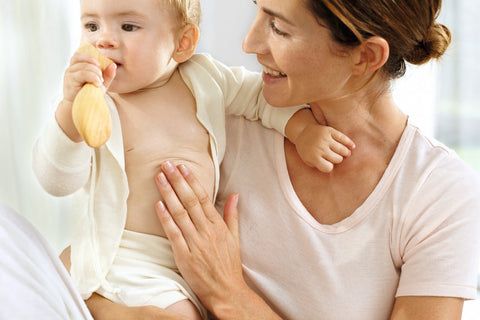
Before anyone handles a newborn, it is important to have clean hands. Always wash your hands with soap and warm water before handling the baby.
Take some time to just hold your baby close. Skin on skin contact is an important element to consider when it comes to the general care and wellbeing of both yourself and your baby.
Baby massage can assist in relaxing both the parent or caregiver and the baby.
Where possible, use oils or lotions that are organic or as natural as possible when massaging your baby.
Make sure your baby is kept warm throughout the massage.
Find the right time to massage your baby. If it’s not working for you both, try a different time.
*Adapted from www.babycentre.co.uk
This article was written by Katrina Wright, in conjunction with episode 5 of Purebaby’s podcast, Pure Parenthood. Katrina is a registered naturopath, massage therapist and Business Development Manager at Weleda Australia. To learn more about Weleda and baby massage, visit their website for more information.
Sign up to Pure Love Rewards and get $10 off your first online order, earn points every time you shop and more!